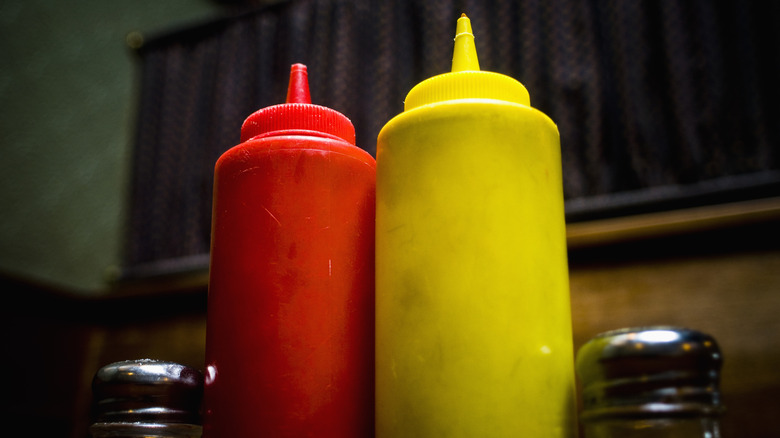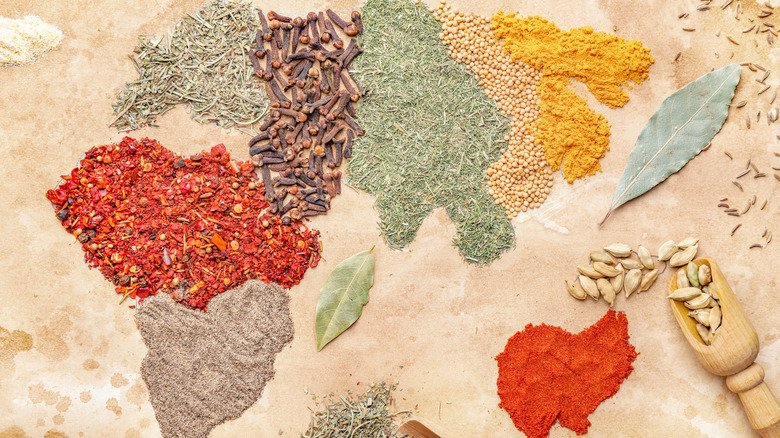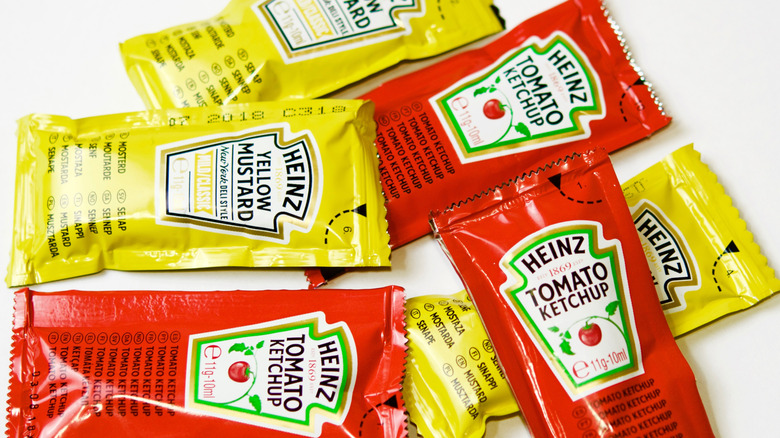How Ketchup And Mustard Became A Popular Pair
Peanut butter and jelly, salt and pepper, ketchup and mustard: There are certain food pairs that are so inextricable from each other that they're often used to describe the tight bond of best friendship ("You're the ketchup to my mustard!"). But how did these two classic condiments come to be so colloquially linked? Why not, say, ketchup and relish?
There's no one clear answer, but there are certain factors that we can point to as probable cause for the pairing. Both have been around in some form for a very long time, with the earliest known documentation of mustard in 3000 B.C. and (an admittedly rather different version of) ketchup in 300 B.C. But their popularization as a pair seems to have mainly occurred in the United States, with mayonnaise and even gravy being popular fry sauces elsewhere in the world. This may be attributable both to the backyard BBQ (think hot dogs, hamburgers) and the popularity of American fast food. Every quick-service joint having their own distinct fast food special sauce is a relatively new development — but you could always count on finding ketchup and mustard packets at your nearby McDonald's. They also keep well and are fairly cheap. And sometimes, the simplest answer is the most true: One sweet, one tangy, these two brightly colored sauces also just taste good together.
A condiment history lesson
Get this: Mustard has been enjoyed by humans since before the Great Pyramids were built, long before Cleopatra was born, and at approximately the same time Stonehenge was being constructed. To be fair, at that point it was eaten in crushed seed form, but even in saucy condiment form it's at least as old as 1390. In other words, it was always destined to be a condiment superstar of the modern era.
Meanwhile, ketchup seems to have been first made in southern China out of fish entrails and soybeans — that's right, ketchup didn't always include tomatoes. In fact, even today different types of ketchup are popular in various parts of the world, from unique condiments like banana ketchup in the Philippines to mushroom ketchup in the U.K. Their united trait is the use of an acid like vinegar or alcohol to preserve the sauce, previously helpful for long ocean voyages or trips on the trade routes, and helpful today because both ketchup and mustard last a long time in the fridge and even a decent chunk of time in the pantry once opened. This makes them kitchen staples that Americans can buy infrequently and always have on hand when needed.
The condiment kings of American food
Part of the reason why, today, more than 90% of American households regularly stock ketchup is because truly, tomato ketchup was perfected in the United States. The commercially produced tomato ketchup of the late 1800s was thicker and sweeter than the previously produced thin and rather watery ketchup considered more of a thin sauce than a dipping one. In 1876, U.S. company Heinz first sold its iconic Tomato Ketchup, and many considered it to be the perfect blend of sweet and salty — which also happens to be the perfect companion to greasy diner or dive-bar food. Between this, the rise of fast food joints along the growing highway system, and the sustained popularity of barbecues, the condiment industry was not hurting for business.
As for mustard, its true power was famously recognized at the 1904 World's Fair, when it was (allegedly) first paired with hot dogs. From there, it joined forces with another All-American staple — baseball — to become the default ballpark hot dog topping that reigns supreme even today. For that matter, as much as we like to think of them as a pair, some Chicagoans would say it should be a crime to even consider putting ketchup on a hot dog and, in doing so, dull the tangy flavor of the mustard. But whether eaten separately or together, Americans have spoken: Ketchup and mustard are simply a match made in heaven.


